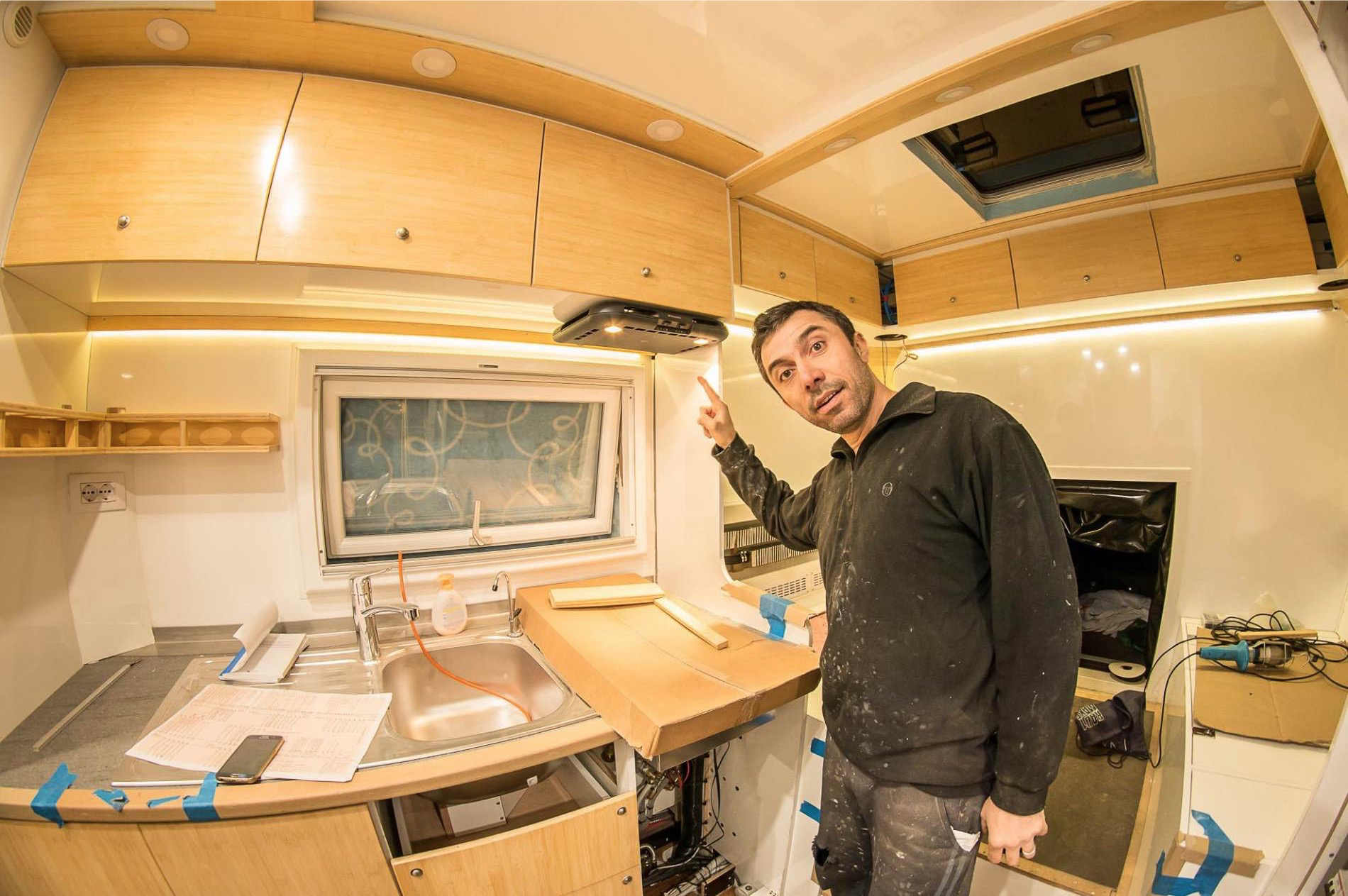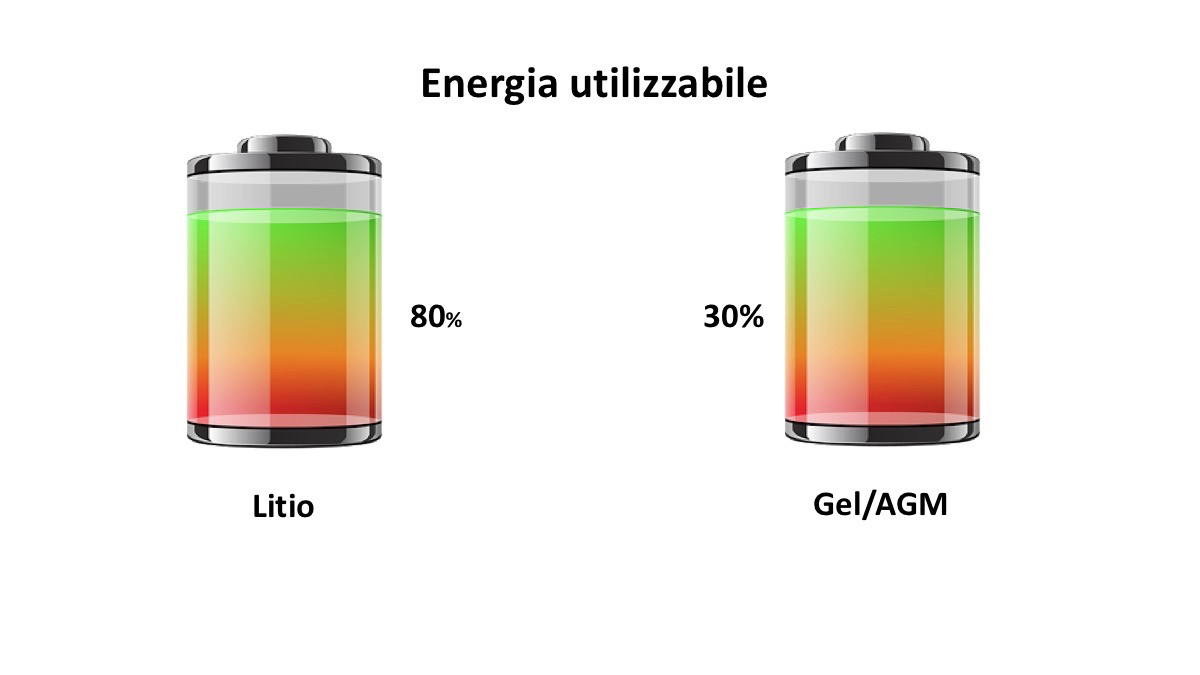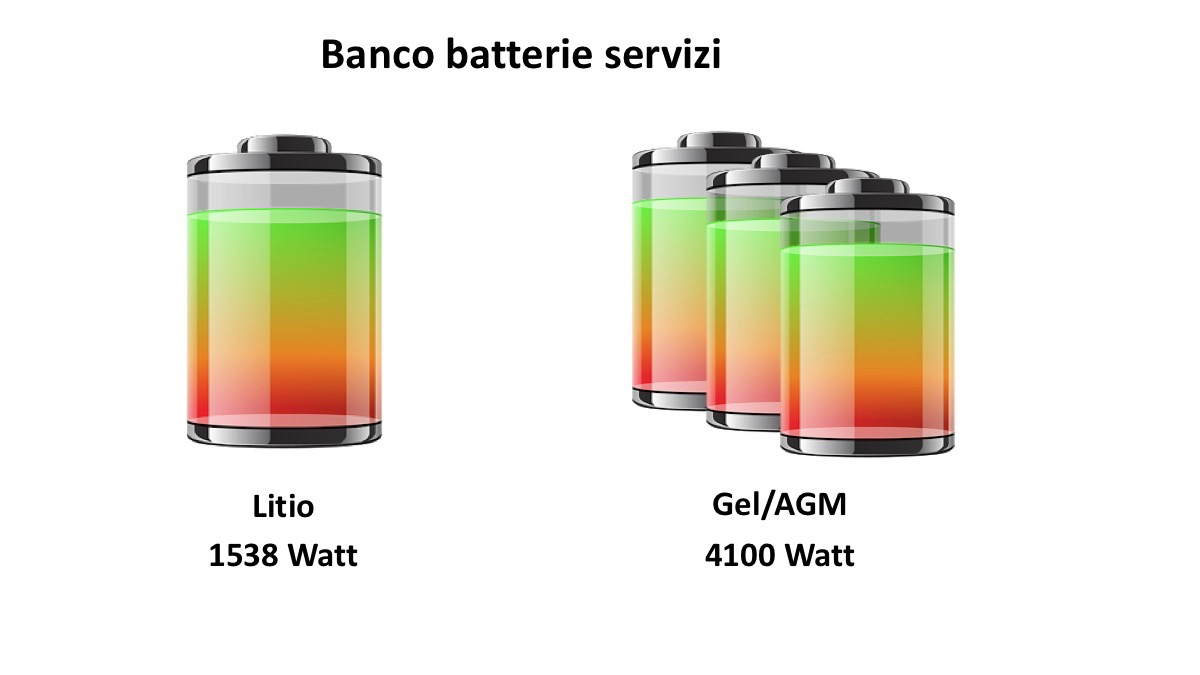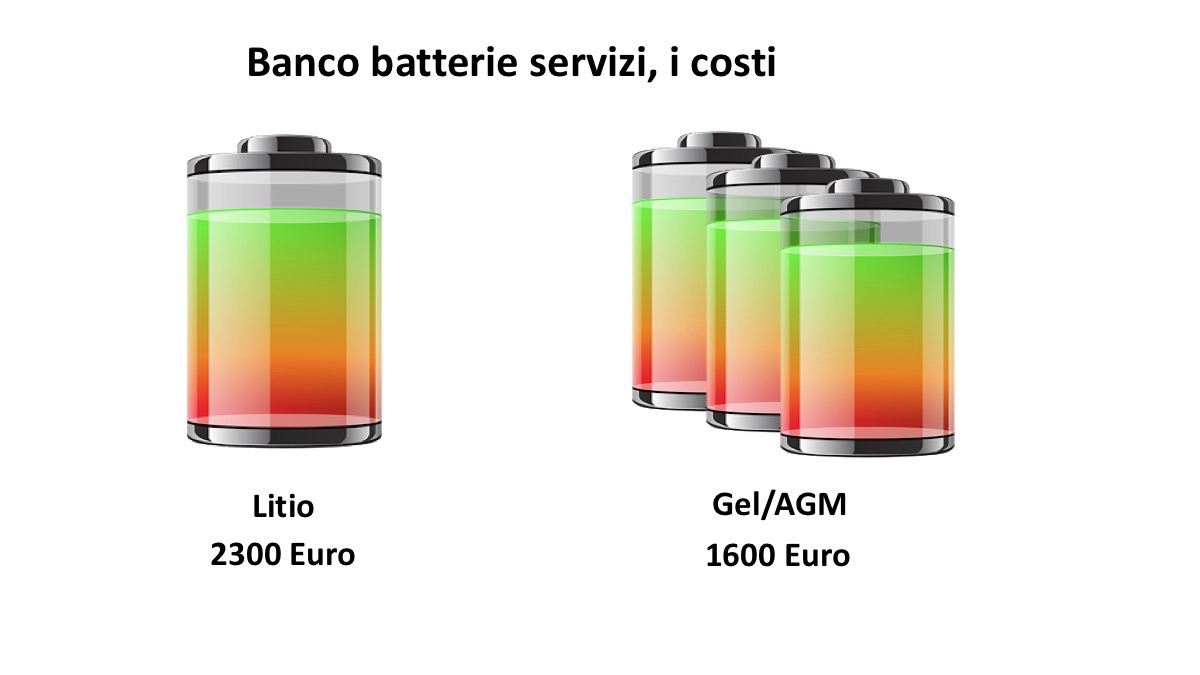This post is also available in: Italiano (Italian)
Independence is the key concept that guided us during the design of our four-wheeler house. In order to gain independence from the power outlets in a lived life on the road it is necessary to evaluate many factors. In this article we want to talk about one of the key elements that characterize the independence of a recreational vehicle, the energy reserve.

When it came time to choose the right batteries for our travel needs on Valentino we have faced several opportunities offered by the market. The presence of different types of batteries does not make it easy to choose from those who do not have great skills in this regard, so be sure to find out before taking the wrong direction. Unfortunately we have to say that we have often received little or no information from the retailers themselves, so attention must be great. In short, whoever seeks to better understand the battery world has no simple road ahead, so we like to share our experience with you.

We will try in this article to help those who have found ourselves, or are grubbing in having to install them from scratch, or replace their battery of service batteries. In doing so, we must introduce the first concept that is not so tied to what the best battery, but rather what is the right battery for your needs. This is very important because we will understand that it is useless to buy more expensive batteries if these are not the correct ones for their use or necessity.
Mainly who as we need a battery of service batteries needs two things: energy reserve and slow discharge.
We do not want to confuse the ideas at once, so we clarify these concepts:
- The energy reserve is basically given by your consumption, which we will see very important to calculate before going to the store or on Ebay. In practice, the batteries are our fuel tank, the more we crush the accelerator and the more we need to stop at the distributor.
- The slow or fast discharge mode is how to use your own power reserve. Normally in a recreational vehicle the mode in question is slow. Slow because the energy we consume within our vehicle is constant, but never requires (or never in standard installations) large amounts of Ampere in a few moments (which happens, for example, in the engine starter batteries) .

How to measure your own consumption (camper, van, truck)
Where do you go from? Having already answered one of our two needs we must begin to understand our reserve requirements.
To understand how much energy we need, we will have to make calculations. To do this we have two possibilities:
- Having the system already installed, we will use a Battery Monitor, a tool that monitors the input and output power of your batteries. There are many in the market, from the simplest to the most complicated. Of those featuring May’s number of functions, there are some that are particularly intuitive, showing instantaneous power consumption in Watt as well as battery temperatures. If you do not have this tool, however, we recommend that you buy it before replacing your batteries, you can use a tester or multimeter that will be able to indicate Ampere, making sure that the maximum load of the instrument support the intended load of your appliances. To be called a sub-dimensioned meter (multimeter) could be broken.

- If you are using a multimeter it is important to remember that the instrument must be positioned so that it can intercept the entire current used. It should not be placed on the single appliance, such as the refrigerator, otherwise you will only measure the consumption of the appliance.

- Since we do not have the installed system we will have to use the datasheet of the devices we plan to use, checking for each of them the expected theoretical consumption. Of course, this measurement will be less accurate, so there will be a certain margin of tolerance so as not to underestimate the implant. This is for a number of reasons, but mainly because the ideal situations present in the lab are almost certainly different from those to which your vehicle will be on the road. In addition, you will miss another interesting information, how and how much you will use that device. Again in this case you have to think about suppositions and once again we recommend overestimating it.
For example:
- The Vitrifrigo DP2600 Refrigerator Datasheet that we installed on Valentine indicates a consumption of 65W per hour (which would multiply for 24 hours would become 1560 Watts per day). This is the consumption that the refrigerator has when the compressor is running, but in the reality of things even the fridge is lit all day does not always need to turn the compressor on. Having made measurements after installation we saw that on average our consumption in the 24 hours is about 350 watts.
Why Measure in Watts?
Knowing what instrument we need, we’ll have to go and measure it, and it’s important to find out what’s needed in Watt instead of Ampere. Specify this because normally you are talking about Ampere, in the datasheet you will find almost always indicated Ampere, which is not wrong but does not always fit our reality. Because? Recalling the basic rule Watt (energy) = Volt (Voltage) * Amp (current) we understand that by using different voltages using different voltages we get very different power consumption. Because within our recreational vehicle we are likely to use different voltages at the same time as 24, 12 and 220 we understand why it is good to do our calculations and then size the system in Watts. Let’s take another example to make things clearer:
- The Datasheet of a 100 liter Dometic Refrigerator indicates a 6.5 Volt power consumption of 12 Volt, which is equivalent to 6.5 (amperes) * 12 (volt) = 78 Watts.
Example of consumption in a recreational vehicle
It’s time to get to know their consumption in order to find the size of your plant.
The best way to understand what to do is to show an example of a standard case that involves installing a refrigerator, autoclave, reading lights, and using a 220 volt user which could be a computer.
- A 100 liter Dometic refrigerator can have an average consumption of around 150 watts per day (of course this depends on many factors.
- A common MacBook computer has a power supply that consumes 85 watts and takes about two hours to completely recharge the batteries, which means 170 watts of total consumption
- A couple of hours a day of reading light from the average power consumption of 10 watts
- A dozen minutes of use of the autoclave pump with an average consumption of 20 watts.
- Using a TV for two hours, equivalent to an average power consumption of 180 watts.
By doing this example we get that the daily consumption of the vehicle would be 615 watts. As said, this value will be very accurate if a Battery Monitor has been used, and should be evaluated properly if it is inferred from the Datasheet.

The reserve
Well, now that we understand how much energy we need every day we will need to calculate how much reserve we need. Eh, why are the batteries just like our fuel tank you remember?
To understand how much reserve we need what we’re interested in knowing? Everything we will find is a fuel distributor. In practice, every few hours (days) will recharge our batteries.
It is not easy to know for a while that information, the main variable being their travel habits and the equipment provided by the vehicle, such as solar panels.
Calculating your reserve number of days is, however, crucial in order to continue with the purchase of battery power, on the contrary we would be in the condition to spend more money than it really is, or more likely, you will be with batteries that will live a difficult life of suffering that will lead to premature death.
Let’s go ahead assuming that you have decided to have a full charge of your batteries one day yes and no. This is because, for example, it is decided not to install solar panels but to go camping, where it will find energy at least once every two days. It’s a plausible, realistic and functional choice.
At this point, the calculation we will have to do is very simple:
- 615 Watts (Daily Consumption) * 2 (days before charging) = 1230 Watts.

Batteries, what are the differences?
We came to this point of the article and still did not talk about the batteries, it looks strange for a text that deals with their choice? We assure you no, all that has been discussed before is probably more important than what follows. What we will discuss later is mostly an economic choice and will provide a personal assessment. But we will accompany you to the end.
What kind of batteries that fit for use in camper, van or lorries are on the market? Basically three: AGM, GEL and Lithium.

We begin to understand what is the substantial difference between GEL and AGM that basically rely on the same technology but differ for the substance that covers the electrolytes. What we care to know is that both can be installed in any location, they can not lose liquids and can essentially be used in poorly ventilated environments. AGM batteries have slightly better performance in terms of faster discharge, while GELs are recommended for slow discharge applications and where there are solar panel installations. GEL batteries also work a bit better at higher temperatures.
These three pure theconologies, adapting very well to the slow release feature, have different characteristics (and also very much). What differentiates them mainly? Apart from the price, which we will see, these batteries differ essentially because of the ability to be deeply discharged, the number of life cycles, the recharge rate to which they can be subjected, by their specific weight and for the price. We do not want to complicate the situation, let’s try to better explain these concepts:
Deeply discharged: in practice it’s how much we can afford to empty our fuel tank. We’ll see how the AGM and GEL batteries force us to keep a lot of fuel in the tank. In short it is like getting full every time but not being able to use it all. A good bang.

Life Cycles: Even simpler, how many times can we go to the distributor after emptying our reserve? In practice, this parameter indicates the longevity in terms of the life of the investment in batteries. Note that often in battery datasets is indicated a lifetime value over the years, but this is valid if the batteries are not used.

Charge rate: Interesting because it indicates how long our batteries can still be used. In practice, we will see how the lithium batteries support high-speed refills, optimizing fuel generator costs, or optimizing the power delivered by solar panels.
The data with which the charge capacity is indicated is the number of times the capacity of the batteries, that is. If a 400Ah battery bank is charged to 1C it means that 400Ah will be given during the charging phase. In the diagram below we see that, for example, Lithium batteries can withstand loads at 0.5C or in the above example 200Ah without the AGM or GEL equivalent being only 400 * 0.2 (0.2C) = 80 Ah. This data is also important for the choice of your charger.

Weight: Banal lithium batteries weigh on average three times less than the others at the same rate as Ampere dispensed.
Price: There is little to be said and done, lithium batteries currently cost a lot. But remembering that these can be downloaded more accurately, additional calculations will have to be made to understand the true cost / benefit ratio. Let’s begin by saying that for example a good quality 12V 220Ah battery can cost about 400 Euros, while buying a 12Volt 200Ah of Euro Lithium will take about 2800.
Batteries, the sizing of your desk services
Given what is described in the previous paragraph we are facing a fundamental choice, Lithium or AGM / GEL?
Let’s take back all of the data we’ve made so far and let’s take two examples to evaluate our needs.
N.B. In our calculations we will consider a use that does not expect to fall below the maximum discharge values expected to achieve maximum lifecycle. To facilitate understanding, we will use a 12-volt battery pack in the example.
Starting from the assumption that we need 1230 watts of reserve we get the following:
- Regarding the GEL / AGM batteries: 1230 Watt / 12 (Nsotro bench voltage) = 102.5 Ampere. However, our bench will have a capacity so that the 102.5 Ampere is at most 30% of the total capacity. So we get our desk to be made up of: 102.5 (Ampere) * 100/30 (Maximum Usage Percentage) = 341 Ampere. These thus amount to a total of 341 Ampere * 12 Volt = 4100 Watts.
- Regardless of the lithium batteries: 1230 Watt / 12 (Nsotro bench voltage) = 102.5 Ampere. However, our bench will have a capacity so that the 102.5 Ampere is at most 80% of the total capacity. So we get our desk to be made up of: 102.5 (Ampere) * 100/80 (Maximum Usage Percentage) = 128 Ampere. These thus amount to a total of 128 Ampere * 12 Volt = 1538 Watts.

This must be added in terms of cycles, which leads to considerable differences in terms of the operating costs of our plant. In practice, evaluating an AGM bench lasting about 1200 cycles compared to the 2500 of the lithium battery bench we get about twice as long for the latter. Let’s look at the specific:
- GEL / AGM battery bank: Two twin-volt 220 Ah batteries are needed to get a 12 Volt 440 Ah benchmark for a total of 5200 watts, enough to cover the calculated 4100 Watt requirement. The average cost of this bank is about 800 Euros. This bench will have to be replaced once (once again), to get to the same lithium bench life, this will cost you 1600 Euros.
- Battery Lithium Battery: A 12 Volt 160 Ah battery will be required to get a power of 1920 watts enough to cover the 1538 watts we have calculated. The average cost of this bench is around 2300 Euros.

However, we want to bring back the weight comparison as well, as we said was definitely in favor of the lithium batteries for a factor of 1 to 3. In the above example, the battery bank at the GEL / AGM would weigh about 130 Kg, compared to about 40 of the equivalent of Lithium, which also has a better ratio in size.

Final considerations
As we have said before describing in detail the different types of batteries, what really matters during the reappraisal phase or installation of their plant is to understand their energy reserve requirements. After that, the choice is up to the portfolio.
What we can give as an indication is the choice we made on our Valentino truck, where we installed a bench made of eight Victron Energy batteries at the GEL for a total capacity of 880 Ampere at 24 Volt, or about 21 Kw of power. This involves the provision of an adequate space that has been divided into two distinct compartments, one under the dim (pictured below) and one in the rear garage.

Although driven by our interest in new theologies, where it is clear that Lithium batteries will be the investment for the future, we have evaluated the choice of investing too much money too premature. Our choice has also been taken into consideration because it is true that lithium batteries require fewer elements, but if they are to fail, the total capacity would also be affected. In the example above, for example, it is evident that the 160 Ampere lithium battery breaks up the total absence of energy as well as a total economic damage of 2300 Euros. Any damage to one of the two AGM batteries would lead to an economic damage of 400 Euros and would limit the use of the system by 50%.
